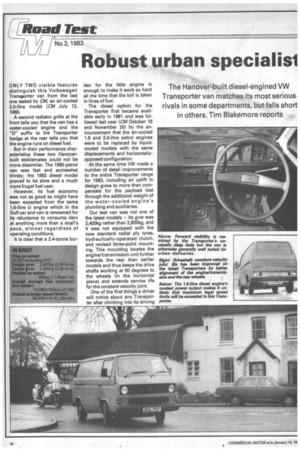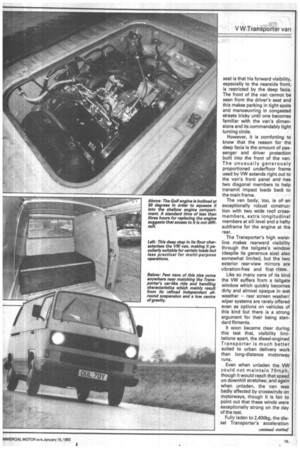Robust urban specialisi
Page 20

Page 21

Page 22

If you've noticed an error in this article please click here to report it so we can fix it.
The Hanover-built diesel-engined VW Transporter van matches its most serious rivals in some departments, but falls short in others. Tim Blakemore reports
ONLY TWO visible features distinguish this Volkswagen Transporter van from the last one tested by CM, an air-cooled 2.0-litre model (CM July 12, 1980.
A second radiator grille at the front tells you that the van has a water-cooled engine and the "D" suffix to the Transporter badge at the rear tells you that the engine runs on diesel fuel.
But in their performance characteristics these two Hanoverbuilt stablemates could not be more dissimilar. The 1980 petrol van was fast and somewhat thirsty; the 1983 diesel model proved to be slow and a much more frugal fuel user.
However, its fuel economy was not as good as might have been expected from the same 1.6-litre ci engine which in the Golf car and van is renowned for its reluctance to consume dery at anything more than a snail's pace, almost regardless of operating conditions.
It is clear that a 2.4-tonne bur
den for the little engine is enough to make it work so hard all the time that the toll is taken in litres of fuel.
The diesel option for the Transporter first became available early in 1981 and was followed last year (CM October 16 and November 20) by the announcement that the air-cooled 1.6 and 2.0-litre petrol engines were to be replaced by liquidcooled models with the same displacements and horizontallyopposed configuration.
At the same time VW made a number of detail improvements to the entire Transporter range for 1983, including an uplift in design gvws to more than compensate for the payload lost through the additional weight of the water-cooled engine's plumbing and auxiliaries.
Our test van was not one of the latest models — its gvw was 2,400kg rather than 2,600kg, and it was not equipped with the now standard radial ply tyres, hydraulically-operated clutch, and revised three-point mounting. This mounting locates the engine/transmission unit further towards the rear than earlier models and thus keeps the drive shafts working at 90 degrees to the wheels (in the horizontal plane) and extends service life for the constant velocity joint.
One of the first things a driver will notice about any Transporter after climbing into its driving seat is that his forward visibility, especially to the nearside front, is restricted by the deep facia. The front of the van cannot be seen from the driver's seat and this makes parking in tight spots and manoeuvring in congested streets tricky until one becomes familiar with the van's dimensions and its commendably tight turning circle.
However, it is comforting to know that the reason for the deep facia is the amount of passenger and driver protection built into the front of the van. The unusually generously proportioned underfloor frame used by VW extends right out to the van's front panel and has two diagonal members to help transmit impact loads back to the main frame.
The van body, too, is of an exceptionally robust construction with two wide roof crossmembers, extra longitudinal members at sill level and a hefty subframe for the engine at the rear.
The Transporter's high waistline makes rearward visibility through the tailgate's window (despite its generous size) also somewhat limited, but the two exterior rear-view mirrors are vibration-free and first class.
Like so many vans of its kind the VW suffers from a tailgate window which quickly becomes dirty and almost opaque in wet weather — rear screen washer/ wiper systems are rarely offered even as options on vehicles of this kind but there is a strong argument for their being standard fitments.
It soon became clear during this test that, visibility limitations apart, the diesel-engined Transporter is much better suited to urban delivery work than long-distance motorway runs.
Even when unladen the VW could not maintain 70mph, though it would reach that speed on downhill stretches; and again when unladen, the van was badly affected by crosswinds on motorways, though it is fair to point out that these winds were exceptionally strong on the day of the test.
Fully laden to 2,400kg, the diesel Transporter's acceleration and top gear performance is decidedly sluggish. Between Sutton and Swanley, a mainly motorway section of our route, the VW's average speed was only 87.4km/h (54.4mph).
Over this section the heavier Talbot Express with a two-litre petrol engine and five-speed gearbox averaged 110.28km/h (68.60mph) a considerable difference.
But in towns and on A-roads the VW manages to hold its own on journey times, even though keeping up with traffic requires virtually constant full throttle driving.
Our histograms in this test compare three load carrying criteria and show that, perhaps surprisingly, in payload, total load platform length and maximum interior height the VW matches up well to its three most serious diesel-engined 2.5-tonne gvw competitors in the UK.
But the Sherpa, Transit and Bedford CF are all considerably more versatile than the VW and each of the British manufacturers offers a much wider range of van models with gvws extending beyond the Transporter's maximum of 2,600kg. VW's offering in the higher weight sector is the soon-to-be-extended LT range.
The Transporter's forward control design makes access to the driver's and passenger seats much more difficult than on normal controls vans but it is easy to walk between the VW's seats to the forward section of the load area The cab trim and seat upholstery are black (surely the most practical colour for a commercial vehicle) and while the seats are firm they are comfortable even on long journeys.
Now that the heating system is conventionally water rather than air-operated it is much improved, but still there is no illumination for the heater controls. Summary Any Transporter van, whether petrol or diesel powered, is more likely to be chosen by an operator who knows exactly what he is going to be carrying than by one who requires a truly general-purpose van.
The diesel-engined Transporter is particularly specialised because of the limitations imposed by its engine's very modest power output, not to mention the relatively poor availability of dery in some parts of the country.
The Transporter D will frustrate any van driver who is in a hurry, yet its fuel bills will always be low and its ride and handling are top notch. But then, so is its price. ,








































































































